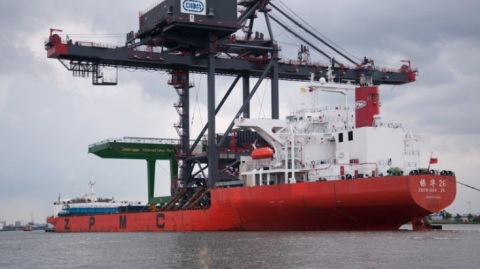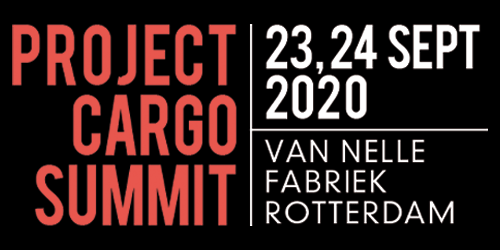Amsterdam cherishes project cargo

The port of Amsterdam is a hub for project cargo. With specialised terminals, including four all-weather terminals and multiple heavy-lift cranes, Amsterdam serves customers with highly diverse cargo needs.
The performance that is staged once every two or three weeks at the Waterland Terminal in Amsterdam is of surrealist proportions. Cranes dance while train carriages come and go, floating back and forth and up and down through the air, pirouetting before disappearing into the hold of a ship. Project cargo: the best thing there is, agrees René Finson, managing director of the terminal. ‘Always different, always varied. No two projects are the same, and neither are the preparations.’
The “performance” involves trains from the Swiss train giant Stadler Rail AG that are being shipped to Russia via Amsterdam. The trains are driven by truck from the Stadler plant to Basel, where they are transferred to a lighter. At the Waterland Terminal, the trains are next moved from the lighter to a coaster – resulting in this spectacular spectacle. Finson: ‘To be clear, our terminal cranes here do not dance. Those are construction cranes, they float and dance.’
Without being blasé, Finson is no longer surprised or excited by the sight of two cranes simultaneously hoisting a double decker wagon. All in a day’s work for him – and for the Waterland Terminal. ‘But the lashing is always still a puzzle’, says Finson, adding that about eighty to ninety of such train shipments have passed through the terminal in the past five years. And besides the trains from Switzerland, there are also trains from the Siemens factory in Germany; confirmation that Waterland is perfectly equipped for the handling of special cargoes. That has everything to do with the type of crane used at the terminal, explains Finson.
‘Ideal for board-board transhipment. The lifting capacity of the crane can cover the full width of the dock. Unlike a quay crane, it can hoist any load onto and from an inland vessel without compromising on lifting capacity. The lifting capacity of a quay crane decreases as you hoist further away from the quay.’
In addition to the cranes, Waterland’s three all-weather terminals are also performing well. In this context, Finson refers to the Scandia Terminal, where he also acts as manager director and where a fourth terminal has been glistening in the sun since August of last year. This All-Weather Terminal (AWT4) is one hundred metres long and 25 metres high, extends over the water for 30 metres and boasts a transhipment crane with a capacity of fifty tonnes. That makes AWT4 three metres wider and four metres higher than the three terminals that were previously constructed at the Waterland Terminal. Bottom line: the construction of this terminal has made Amsterdam the largest provider of covered transhipment in Europe.
Finson adds that AWT4 has a wide impact on project cargo. ‘How so? Well, the facility in general. Particularly remarkable is the hoisting height, which is truly unique. Everything is a big word, but we can definitely handle most cargo at Scandia.’
Turbines
Trains are not the only project cargo to pass through the terminal. Finson mentions – particularly relevant at the time of speaking – parts of dismantled wind turbines. ‘Pylons, blades and turbines. Fifteen metres long, 120 tonnes of weight. But also large storage tanks for factories and breweries that are to be newly built. These brew kettles often come from Germany and are moved across the world through us.’
Continuing on project cargo in the port of Amsterdam: when asked about inhibiting and stimulating developments, Finson starts with the negative; the tensions between the EU and Russia, resulting in a decline in project cargo volumes. The door to a sales market has closed, says Finson as he points to the door of his office. ‘Project cargo used to be moved there on a highly regular basis, but for the time being this has stopped and the impact is substantial.’ Activities related to wind turbines on the other hand positively impact volumes.
TMA
Waterland and Scandia however are not the only locations in the port of Amsterdam where project cargo is in good hands. Meet Michael van Toledo, general director of TMA Logistics. He explains that project cargo accounts for roughly a quarter of TMA’s capacity and, in addition to containers, ro-ro and break bulk, constitutes an important logistics segment for the terminals in Amsterdam and Velsen.
‘With a deep-sea quay of more than 1,500 metres in length and a site capacity of 550,000 m2, we are able to accommodate pretty much any project. Currently, we serve as a logistics hub for the construction of the large sea lock that is to be completed at IJmuiden in 2020. There are also a number of major wind turbine projects scheduled for both 2019 and 2020 in which some two hundred turbines of the largest category will be moved through our terminal to their final destinations on both land and water.’
In Van Toledo’s vision on the future he sees no obstacles limiting the possibilities. On the contrary. ‘The sea lock will improve the access to our terminals even further. The most important aspects for large projects are space, expertise and logistics solutions. In collaboration with partners in the Amsterdam port region, we have sufficient lifting capacity to handle the heaviest projects. In order to be able to anticipate projects, we can be flexible in the range of space and services we offer.’
Magic
Ants Tilma, commercial manager at Port of Amsterdam, also praises the flexibility of ‘her’ port in terms of project cargo. She refers to the state of affairs as ‘the magic of Amsterdam’s project cargo’. Tilma: ‘Used onshore wind turbines arrive at Waterland in parts by truck or inland vessel and are then further transported as project cargo by coaster to Sweden; but they can also just as easily be moved to the neighbours for onward transport as ro-ro cargo aboard a deep-sea/car carrier to Australia.’
All well and good, but what role exactly does Port of Amsterdam play in the process? Mainly a supporting one, explains Tilma. ‘The starting point in our thinking is logical logistics. That means achieving maximum returns with smart, relatively small investments.’
One example Tilma mentions is adding an extra bollard in a port basin to substantially increase the reach of a quay – and of the entrepreneur behind it. According to Tilma, Port of Amsterdam commits itself to enthuse neighbouring entrepreneurs in such cases. ‘Our tasks also include the stimulation of cooperation between companies. One way we can achieve this is by disseminating knowledge about what other companies are doing – also in completely different sectors – and regularly making unexpected connections. This is important because there is an imbalance between incoming and outgoing cargo in certain segments in the port of Amsterdam and the linking of sub-loads is profitable to everyone. In order to utilise possibilities, you need to know what they are. If this applies to any type of cargo, then it is project cargo.’
Koen Overtoom, CEO of Port of Amsterdam, will be present at Project Cargo Summit. On the second day he will participate in the Portpanel. Check out the conference programme.
Register now for the Project Cargo Summit.
Author: Cees Visser
Date: 20th of June, 2018
morenews
Project Cargo Summit 2024 programme takes shape
Excitement is building for the Project Cargo Summit 2024 in Bilbao, Spain! The dates are locked in (September 17th and 18th), the speaker list is filling up fast, and preparations are underway to make the “Project Cargo Summit 2024: Mega Cargo, Mega Solutions” an unforgettable event.
Project Cargo Summit 2024 registrations open
The time has come, we have opened registrations for this year’s edition of the Project Cargo Summit. As it was previously unveiled, the Port of Bilbao will be our host on September 17 and 18. There have been some changes since the announcement.
Project Cargo Summit goes to Bilbao
Following the successful outing in Bremen in 2023, ProMedia and its Project Cargo Summit team have turned their sights to a new adventure and have partnered with the Port of Bilbao. So for the 2024 edition of the Project Cargo Summit, project cargo, breakbulk and heavy lift industry specialists will gather in Bilbao for two… Read more ›
